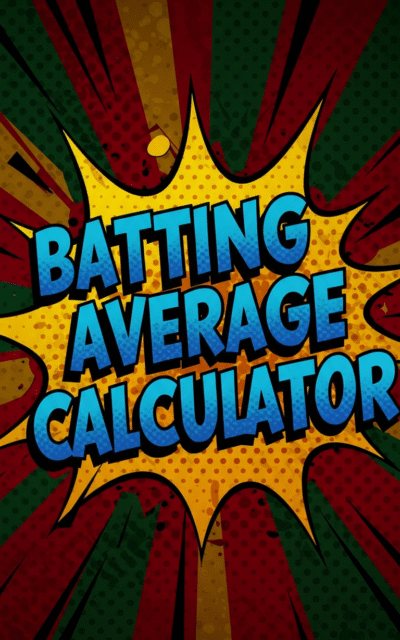Batting Average Calculator
Calculate your baseball batting average instantly with our free tool. Enter hits and at-bats to get accurate AVG stats for players of all levels.
Guide
What is a Batting Average Calculator?
The Batting Average Calculator is a simple tool that helps baseball and softball players, coaches, and fans calculate a player’s batting average (AVG), which is a fundamental baseball statistic that measures a batter’s success at the plate by dividing the number of hits by the number of at-bats.
How to Calculate Batting Average
The formula for calculating batting average is:
Batting Average (AVG) = Hits ÷ At BatsThe result is typically displayed as a three-digit decimal number (e.g., .300 instead of 0.300).
Features of Our Calculator
- Quick and accurate calculations
- Simple user interface
- Real-time results
How to Use
- Enter the number of hits in the “Hits” field
- Enter the number of at-bats in the “At Bats” field
- The calculator automatically processes the information
- View your result in the output section
- Use the reset button to perform new calculations
Why Use a Batting Average Calculator?
- Time-saving: Get instant results without manual calculations
- Accuracy: Eliminate human error in your statistics
- Track performance: Monitor batting averages throughout a season
- Compare players: Easily calculate and compare different players’ averages
- Educational: Help young players understand baseball statistics
Understanding Batting Average
Batting average has been a standard measure of hitting performance in baseball for over a century. While a perfect batting average would be 1.000 (getting a hit every time at bat), even the best professional hitters typically achieve averages around .300, meaning they get a hit 30% of the time.
| Batting Average | General Assessment |
|---|---|
| .300+ | Excellent |
| .275 to .299 | Above Average |
| .250 to .274 | Average |
| .225 to .249 | Below Average |
| Below .225 | Poor |
Remember that batting average only accounts for hits and doesn’t consider walks, hit-by-pitches, or the type of hit (single, double, etc.). Modern baseball analysis often uses additional statistics like on-base percentage (OBP) and slugging percentage (SLG) to provide a more complete picture of a batter’s performance.
FAQ
-
How accurate is a batting average as a measure of a player's hitting ability?
Batting average provides a basic measure of hitting ability but has limitations. It doesn't account for types of hits (singles vs. home runs) or walks. More comprehensive metrics like OPS (On-base Plus Slugging) offer a more complete picture of a player's offensive value.
-
What's considered a good batting average in baseball?
A batting average above .300 is generally considered excellent in professional baseball. The league average typically hovers around .250, though this can vary by era and level of play. In MLB history, very few players have maintained a career average above .330
-
Why doesn't batting average include walks or hit-by-pitches?
Batting average specifically measures success on balls put in play that result in hits. Walks and hit-by-pitches are measured separately in on-base percentage (OBP) because they represent plate discipline rather than hitting ability.
-
How do I calculate batting average for a team?
To calculate a team's batting average, divide the total number of hits by all players by the total number of at-bats. This gives you the collective batting average: Team AVG = Total Team Hits ÷ Total Team At-Bats.
-
Can batting average be calculated mid-game?
Yes, batting average can be calculated at any point, but it's most meaningful over larger sample sizes. For in-game situations, simply divide current hits by current at-bats, though small sample sizes can produce extreme results.
-
How does batting average differ from slugging percentage?
Batting average treats all hits equally, while slugging percentage assigns more value to extra-base hits. Slugging percentage is calculated by dividing total bases (1 for singles, 2 for doubles, etc.) by at-bats, measuring hitting power rather than just hit frequency.
-
Is there a minimum number of at-bats needed for a meaningful batting average?
Yes, batting average becomes more reliable with larger sample sizes. In MLB, players need 3.1 plate appearances per team game to qualify for batting titles (about 502 plate appearances in a 162-game season). Smaller samples can lead to misleading results
Install Our Extensions
Add IO tools to your favorite browser for instant access and faster searching
恵 Scoreboard Has Arrived!
Scoreboard is a fun way to keep track of your games, all data is stored in your browser. More features are coming soon!

